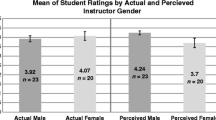Abstract
Male and female students have displayed different reactions to the gender of their faculty. This research was designed to explore whether biases exist early in the school term. Students’ unfavorable attitudes toward instructors were measured by the extent to which they delayed completing a course requirement: participation in a subject pool. Students scheduled a date upon which to participate in a research study. Discrepancies between their scheduled and their actual participation dates reveal that male students delayed their requirement (a) more when their instructors were female than when they were male, and (b) more than female students when the instructors were female. Supporting data suggest that the delayed completion time reflects lower evaluations of female faculty. Discussion focuses on implications in academic settings.
Similar content being viewed by others
References
Basow, S. A. (2000). Best and worst professors: Gender patterns in students’ choices. Sex Roles, 43, 407–417.
Basow, S. A., & Silberg, N. T. (1987). Student evaluations of college professors: Are female and male professors rated differently? Journal of Educational Psychology, 79, 308–314.
Bass, B. M., & Stogdill, R. M. (1990). Women and leadership. In B. M. Bass (Ed.), Bass & Stogdill’s handbook of leadership: Theory, research, and managerial applications (3rd ed., pp. 707–737). New York: Free Press.
Baumeister, R. F. (1982). A self-presentational view of social phenomena. Psychological Bulletin, 91, 3–26.
Bennett, S. K. (1982). Student perceptions of and expectations for male and female instructors: Evidence relating to the question of gender bias in teaching evaluation. Journal of Educational Psychology, 74, 170–179.
Christensen-Szalanski, J. J. J., & Willham, C. F. (1991). The hindsight bias: A meta-analysis. Organizational Behavior and Human Decision Processes, 48, 147–168.
Eagly, A. H. (1987). Sex differences in social behavior: A social-role interpretation. Hillsdale, NJ: Erlbaum.
Eagly, A. H., Makhijani, M. G., & Klonsky, B. G. (1992). Gender and the evaluation of leaders: A meta-analysis. Psychological Bulletin, 111, 3–22.
Funder, D. C. (1987). Errors and mistakes: Evaluating the accuracy of social judgments. Psychological Bulletin, 101, 75–90.
Goldberg, G. F., & Callahan, J. P. (1991). Comparative analyses of instructor ranking based on student evaluations. College Student Journal, 25, 198–200.
Gordon, T. (1977). T.E.T.: Teacher effectiveness training. New York: McKay.
Greenwald, A. G., McGhee, D. E., & Schwartz, J. L. K. (1998). Measuring individual differences in implicit cognition: The implicit association test., Journal of Personality and Social Psychology, 74, 1464–1480.
Louie, T. A. (1999). Decision makers’ hindsight bias after receiving favorable and unfavorable feedback. Journal of Applied Psychology, 84, 29–41.
Louie, T. A., Curren, M. T., & Harich K. (2000). ‘I knew we would win’: Hindsight bias for favorable and unfavorable team decision outcomes. Journal of Applied Psychology, 85, 264–272.
Rice, R. W., Bender, L. R., & Vitters, A. G. (1980). Leader sex, follower attitudes toward women, and leadership effectiveness: A laboratory experiment. Organizational Behavior & Human Decision Processes, 25, 46–78.
Rosenfeld, L. B. (1983). Communication climate and coping mechanisms in the college classroom. Communication Education, 32, 167–174.
Ruth, J. A., Otnes, C. C., & Brunel, F. (1999). Gift receipt and the reformulation of interpersonal relationships. Journal of Consumer Research, 25, 385–402.
Sandler, B. R. (1991). Women faculty at work in the classroom, or why it still hurts to be a woman in labor. Communication Education, 40, 6–15.
Sidanius, J., & Crane, M. (1989). Job evaluation and gender: The case of university faculty. Journal of Applied Social Psychology, 19, 174–197.
Tom, G. (1998). Faculty and student perceptions of classroom etiquette. Journal of College Student Development, 39, 515–517.
Van Giffen, K. (1990). Influence of professor gender and perceived use of humor on course evaluations. Humor, 3, 65–73.
Whyte, W. F. (1949). The social structure of the restaurant. American Journal of Sociology, 54, 302–310.
Author information
Authors and Affiliations
Corresponding author
Rights and permissions
About this article
Cite this article
Louie, T.A., Tom, G. Timely Completion of Class Requirements: Effects of Student and Faculty Gender. Sex Roles 52, 245–250 (2005). https://doi.org/10.1007/s11199-005-1299-z
Issue Date:
DOI: https://doi.org/10.1007/s11199-005-1299-z




